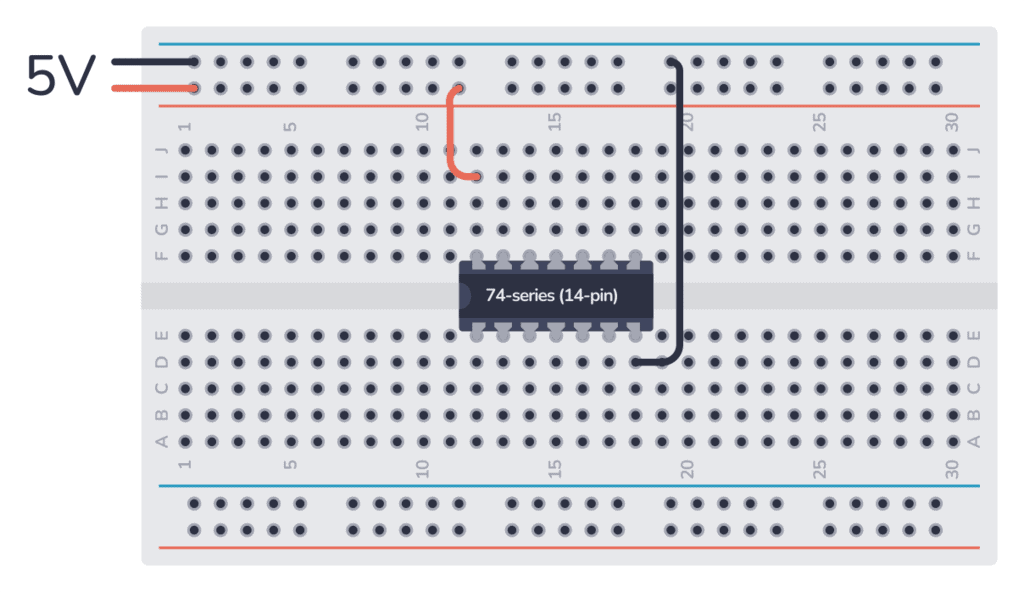The 74×38 (ex 74LS38) is a chip contains four open-collector NAND gates. When you have an open collector output, it means it’s easy to connect it to other chips that use different logic levels. However, it also means you can’t just swap it out with a regular NAND gate chip
Learn how it works and how to use it with this beginner-friendly guide and start using NAND gates in your projects.

What does the 74LS38 do?
The 74×38 gives you four open-collector NAND gates that you can use individually. A NAND gate is a logic gate that outputs 0 (LOW) only if all of its inputs are 1 (HIGH). In the truth table below, you can see what the output will be for any given input:

How To Use This Chip
The 74LS38 comes in a 14-pin package, and you need to connect its power pins before you can use it. Most 7400 ICs like this one support a VCC voltage of 5V.

This chip uses open-collector outputs which means you can only sink current, not source it.
The output of each gate in the 74LS38 can sink around 24 to 48 milliamps when it’s powered with 5 volts. But, this might differ depending on the chip manufacturer.

74×38 Pinout
The 74×38 has 14 pins and contains four open-collector NAND gates laid out as shown in the pinout diagram below:

| Pin # | Type | Description |
|---|---|---|
| 1 | Input | Input to the first NAND gate. |
| 2 | Input | Input to the first NAND gate. |
| 3 | Output | Open-collector output from the first NAND gate. |
| 4 | Input | Input to the second NAND gate. |
| 5 | Input | Input to the second NAND gate. |
| 6 | Output | Open-collector output from the second NAND gate. |
| 7 | Power | Connect to ground (GND). |
| 8 | Output | Open-collector output from the third NAND gate. |
| 9 | Input | Input to the third NAND gate. |
| 10 | Input | Input to the third NAND gate. |
| 11 | Output | Open-collector output from the fourth NAND gate. |
| 12 | Input | Input to the fourth NAND gate. |
| 13 | Input | Input to the fourth NAND gate. |
| 14 | Power | Positive power supply (VCC). Connect to +5V power. |
Alternatives and Equivalents for 74LS38
There are many versions of the 74×38 chip. They all have the same functionality, but with different specifications such as supported voltages and maximum current output.

10 Simple Steps to Learn Electronics
Electronics is easy when you know what to focus on and what to ignore. Learn what "the basics" really is and how to learn it fast.
Here’s a list of a few equivalents of this chip:
- 74HC38 (High-speed CMOS)
- 74HCT38 (High-speed CMOS, TTL compatible)
- 74LS38 (High-speed TTL)
- 74LVC38 (Low Voltage TTL)
- 74AC38 (Advanced CMOS)
- 74ALS38 (Advanced Low-Power Schottky TTL)
- 74F38 (Very High Speed)
- 74C38 (CMOS, similar to the 4000-series)
- 7438 and 74S38
Some manufacturers also add a prefix, such as the SN74LS38 by Texas Instruments or DM74LS38 by Fairchild.
Can’t find the 74×38 anywhere? Then try one of the following IC alternatives:
- 74×00 – Quad 2-input NAND gates.
- 74×01 – Quad 2-input NAND gates (with open-collector outputs).
- 74×03 – Quad 2-input NAND gates (with open-collector outputs).
- 74×24 – Quad 2-input NAND gates (with Schmitt-trigger inputs).
- 74×26 – Quad 2-input NAND gates (with open-collector outputs that support 15V).
- 74×37 – Quad 2-input NAND gates with buffered outputs.
- 74×132 – Quad 2-input NAND gates (with Schmitt-trigger inputs).
- CD4011 – Quad 2-input NAND gates.
- CD4093 – Quad 2-input NAND gates (with Schmitt-trigger inputs).
If you can’t find the 74×38 IC in your local electronics store, don’t worry, you’ll most likely find it in one of the stores listed on this page of online stores where you’ll find components and tools for all your electronics projects.
Datasheet for the 74LS38 and 74HC38 chips
Download the PDF datasheet for your version of the 74×38 here:

Get the 555 Timer Cheatsheet
A super helpful reference that makes it easy to design circuits, so that you can build oscillators, timer circuits, and more in no time.

